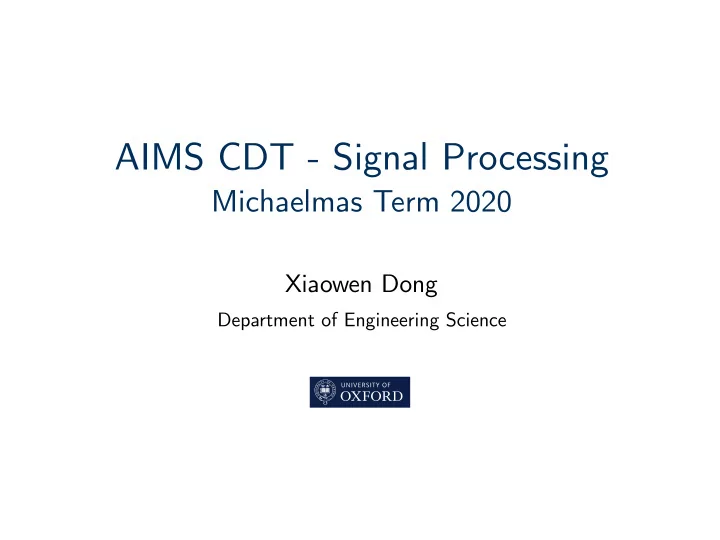

AIMS CDT - Signal Processing Michaelmas Term 2020 Xiaowen Dong Department of Engineering Science
Outline • Lectures - Monday-Thursday 10:00-12:00 - slides: http://www.robots.ox.ac.uk/~xdong/teaching.html • Lab sessions - Tuesday & Wednesday 14:00-17:00 - notes: http://www.robots.ox.ac.uk/~xdong/teaching.html - lab demonstrators Henry Kenlay (henry.kenlay@worc.ox.ac.uk) - Alan Chau (siu.chau@spc.ox.ac.uk) - Yin-Cong Zhi (yin-cong.zhi@st-annes.ox.ac.uk) - • A light-weight assignment - to be submitted to xdong@robots.ox.ac.uk by Monday Oct 26th 18:00 • Questions & Comments - Xiaowen Dong (xdong@robots.ox.ac.uk) 2 /76
Outline • Part I Classical signal processing - Day 1 Introduction: Basic concepts and tools (thanks to Steve Roberts) linear systems, convolution, time-frequency analysis - fi ltering, analogue & digital fi lters - - Day 2 Representation of signals time-frequency representation - Fourier & wavelet transforms, dictionary learning - • Part II Graph signal processing (GSP) - Day 3 Introduction to GSP graph signals, graph Fourier transform - fi ltering and representation of graph signals - - Day 4 Graph neural networks (Guest lecture by Dorina Thanou) graph convolution, localisation - spatial-domain vs spectral-domain designs - 3 /76
Textbooks (Part I) Lynn. An introduction to the analysis and • processing of signals. Macmillan, 1989. Oppenheim and Schafer. Digital signal • processing. Prentice Hall, 1975. Proakis and Manolakis. Digital signal processing: • Principles, algorithms and applications. Prentice Hall, 2007 Orfanidis. Introduction to signal processing. • Prentice Hall, 1996. Available online at http://eceweb1.rutgers.edu/~orfanidi/intro2sp/ 4 /76
Textbooks (Part I) Vetterli et al. Foundations of signal processing. • Cambridge University Press, 2014. Available online at http://www.fourierandwavelets.org Kova č evi ć et al. Fourier and wavelet signal • processing. Available online at http://www.fourierandwavelets.org Toolboxes MATLAB Signal Processing Toolbox: • - https://www.mathworks.com/help/signal/ SciPy Signal Processing Toolbox: • - https://docs.scipy.org/doc/scipy/reference/tutorial/signal.html - https://scipy-cookbook.readthedocs.io/items/idx_signal_processing.html 5 /76
Introduction Basic Concepts and Tools 6 /76
Historical notes smoke signal tower (1570) semaphore telegraph (1792) Morse code (1830s) electronic communication (today) 7 /76
Modern signal processing applications speech processing image denoising EEG signal classi fi cation seismology 8 /76
Signal types continuous time discrete continuous sampling t t T quantisation amplitude analogue signal discrete t t T digital signal 9 /76
Analogue vs. Digital signal processing • Many signals of practical interest are analogue: e.g., speech, seismic, radar, and sonar signals • Analogue signal processing systems are based on analogue equipment: e.g., channel vocoder • Dramatic advance of digital computing moves the trend towards digital systems 10 /76
Linear systems • Principle of superposition ax 1 ( t ) + bx 2 ( t ) ay 1 ( t ) + by 2 ( t ) system • Frequency preservation: F out ⊆ F in system t t • Can be broken down into simpler sub-systems sub- sub- sub- sub- system x x x ≡ ≡ system system system system 11 /76
Time-invariant systems • Time-invariance x ( t ) y ( t ) x ( t − t 0 ) y ( t − t 0 ) system system t t t 0 t t t 0 12 /76
<latexit sha1_base64="sMVpIDSMWNiacT6Mq8Du+txYSOE=">ACFnicbVC7SgNBFJ31bXxFLSxsBoMQm7ArghYWQRsbIYKJgWwIs5O7yeDs7DpzVxPW/Ie9rf6Cndja+gd+hpNH4evAhcM593LvPUEihUHX/XCmpmdm5+YXFnNLyura/n1jZqJU82hymMZ63rADEihoIoCJdQTDSwKJFwF16dD/+oWtBGxusR+As2IdZQIBWdopVZ+675XxL17X8INPW/16DH1hQqx38oX3JI7Av1LvAkpkAkqrfyn345GoFCLpkxDc9NsJkxjYJLGOT81EDC+DXrQMNSxSIwzWz0wIDuWqVNw1jbUkhH6veJjEXG9KPAdkYMu+a3NxT/8xophkfNTKgkRVB8vChMJcWYDtOgbaGBo+xbwrgW9lbKu0wzjazH1ugh0zr+M4MbDTe7yD+ktp+yXNL3sVBoXwyCWmBbJMdUiQeOSRlckYqpEo4GZBH8kSenQfnxXl13satU85kZpP8gP+Bfvpn4o=</latexit> <latexit sha1_base64="sMVpIDSMWNiacT6Mq8Du+txYSOE=">ACFnicbVC7SgNBFJ31bXxFLSxsBoMQm7ArghYWQRsbIYKJgWwIs5O7yeDs7DpzVxPW/Ie9rf6Cndja+gd+hpNH4evAhcM593LvPUEihUHX/XCmpmdm5+YXFnNLyura/n1jZqJU82hymMZ63rADEihoIoCJdQTDSwKJFwF16dD/+oWtBGxusR+As2IdZQIBWdopVZ+675XxL17X8INPW/16DH1hQqx38oX3JI7Av1LvAkpkAkqrfyn345GoFCLpkxDc9NsJkxjYJLGOT81EDC+DXrQMNSxSIwzWz0wIDuWqVNw1jbUkhH6veJjEXG9KPAdkYMu+a3NxT/8xophkfNTKgkRVB8vChMJcWYDtOgbaGBo+xbwrgW9lbKu0wzjazH1ugh0zr+M4MbDTe7yD+ktp+yXNL3sVBoXwyCWmBbJMdUiQeOSRlckYqpEo4GZBH8kSenQfnxXl13satU85kZpP8gP+Bfvpn4o=</latexit> <latexit sha1_base64="sMVpIDSMWNiacT6Mq8Du+txYSOE=">ACFnicbVC7SgNBFJ31bXxFLSxsBoMQm7ArghYWQRsbIYKJgWwIs5O7yeDs7DpzVxPW/Ie9rf6Cndja+gd+hpNH4evAhcM593LvPUEihUHX/XCmpmdm5+YXFnNLyura/n1jZqJU82hymMZ63rADEihoIoCJdQTDSwKJFwF16dD/+oWtBGxusR+As2IdZQIBWdopVZ+675XxL17X8INPW/16DH1hQqx38oX3JI7Av1LvAkpkAkqrfyn345GoFCLpkxDc9NsJkxjYJLGOT81EDC+DXrQMNSxSIwzWz0wIDuWqVNw1jbUkhH6veJjEXG9KPAdkYMu+a3NxT/8xophkfNTKgkRVB8vChMJcWYDtOgbaGBo+xbwrgW9lbKu0wzjazH1ugh0zr+M4MbDTe7yD+ktp+yXNL3sVBoXwyCWmBbJMdUiQeOSRlckYqpEo4GZBH8kSenQfnxXl13satU85kZpP8gP+Bfvpn4o=</latexit> <latexit sha1_base64="sMVpIDSMWNiacT6Mq8Du+txYSOE=">ACFnicbVC7SgNBFJ31bXxFLSxsBoMQm7ArghYWQRsbIYKJgWwIs5O7yeDs7DpzVxPW/Ie9rf6Cndja+gd+hpNH4evAhcM593LvPUEihUHX/XCmpmdm5+YXFnNLyura/n1jZqJU82hymMZ63rADEihoIoCJdQTDSwKJFwF16dD/+oWtBGxusR+As2IdZQIBWdopVZ+675XxL17X8INPW/16DH1hQqx38oX3JI7Av1LvAkpkAkqrfyn345GoFCLpkxDc9NsJkxjYJLGOT81EDC+DXrQMNSxSIwzWz0wIDuWqVNw1jbUkhH6veJjEXG9KPAdkYMu+a3NxT/8xophkfNTKgkRVB8vChMJcWYDtOgbaGBo+xbwrgW9lbKu0wzjazH1ugh0zr+M4MbDTe7yD+ktp+yXNL3sVBoXwyCWmBbJMdUiQeOSRlckYqpEo4GZBH8kSenQfnxXl13satU85kZpP8gP+Bfvpn4o=</latexit> <latexit sha1_base64="Auq2gnW2Fm3d7aMl+qYL0lRMISM=">ACF3icbVA9SwNBEN2L3/EraiPYLAYhNuFOBC0sgjY2QgSjQhLC3mZOl+ztnbtz6hHj/7C31b9gJ7aW/gN/hpt4hUl8MPB4b4aZeX4shUHX/XJyE5NT0zOzc/n5hcWl5cLK6rmJEs2hxiMZ6UufGZBCQ0FSriMNbDQl3Dhd476/sUtaCMidYZpDM2QXSkRCM7QSq3C+kNawu0H2pBwQ09aKT2gDaECTFuFolt2B6DjxMtIkWSotgrfjXbEkxAUcsmMqXtujM0u0yi4hF6+kRiIGe+wK6hbqlgIptkdfNCjW1Zp0yDSthTSgfp3ostCY9LQt50hw2sz6vXF/7x6gsF+sytUnCAo/rsoSCTFiPbjoG2hgaNMLWFcC3sr5dM42tKEtcI9M6+jO9Gw03mgQ4+R8p+y5Ze90t1g5zEKaJRtk5SIR/ZIhRyTKqkRTh7JM3khr86T8+a8Ox+/rTknm1kjQ3A+fwBcJZ+2</latexit> <latexit sha1_base64="Auq2gnW2Fm3d7aMl+qYL0lRMISM=">ACF3icbVA9SwNBEN2L3/EraiPYLAYhNuFOBC0sgjY2QgSjQhLC3mZOl+ztnbtz6hHj/7C31b9gJ7aW/gN/hpt4hUl8MPB4b4aZeX4shUHX/XJyE5NT0zOzc/n5hcWl5cLK6rmJEs2hxiMZ6UufGZBCQ0FSriMNbDQl3Dhd476/sUtaCMidYZpDM2QXSkRCM7QSq3C+kNawu0H2pBwQ09aKT2gDaECTFuFolt2B6DjxMtIkWSotgrfjXbEkxAUcsmMqXtujM0u0yi4hF6+kRiIGe+wK6hbqlgIptkdfNCjW1Zp0yDSthTSgfp3ostCY9LQt50hw2sz6vXF/7x6gsF+sytUnCAo/rsoSCTFiPbjoG2hgaNMLWFcC3sr5dM42tKEtcI9M6+jO9Gw03mgQ4+R8p+y5Ze90t1g5zEKaJRtk5SIR/ZIhRyTKqkRTh7JM3khr86T8+a8Ox+/rTknm1kjQ3A+fwBcJZ+2</latexit> <latexit sha1_base64="Auq2gnW2Fm3d7aMl+qYL0lRMISM=">ACF3icbVA9SwNBEN2L3/EraiPYLAYhNuFOBC0sgjY2QgSjQhLC3mZOl+ztnbtz6hHj/7C31b9gJ7aW/gN/hpt4hUl8MPB4b4aZeX4shUHX/XJyE5NT0zOzc/n5hcWl5cLK6rmJEs2hxiMZ6UufGZBCQ0FSriMNbDQl3Dhd476/sUtaCMidYZpDM2QXSkRCM7QSq3C+kNawu0H2pBwQ09aKT2gDaECTFuFolt2B6DjxMtIkWSotgrfjXbEkxAUcsmMqXtujM0u0yi4hF6+kRiIGe+wK6hbqlgIptkdfNCjW1Zp0yDSthTSgfp3ostCY9LQt50hw2sz6vXF/7x6gsF+sytUnCAo/rsoSCTFiPbjoG2hgaNMLWFcC3sr5dM42tKEtcI9M6+jO9Gw03mgQ4+R8p+y5Ze90t1g5zEKaJRtk5SIR/ZIhRyTKqkRTh7JM3khr86T8+a8Ox+/rTknm1kjQ3A+fwBcJZ+2</latexit> <latexit sha1_base64="Auq2gnW2Fm3d7aMl+qYL0lRMISM=">ACF3icbVA9SwNBEN2L3/EraiPYLAYhNuFOBC0sgjY2QgSjQhLC3mZOl+ztnbtz6hHj/7C31b9gJ7aW/gN/hpt4hUl8MPB4b4aZeX4shUHX/XJyE5NT0zOzc/n5hcWl5cLK6rmJEs2hxiMZ6UufGZBCQ0FSriMNbDQl3Dhd476/sUtaCMidYZpDM2QXSkRCM7QSq3C+kNawu0H2pBwQ09aKT2gDaECTFuFolt2B6DjxMtIkWSotgrfjXbEkxAUcsmMqXtujM0u0yi4hF6+kRiIGe+wK6hbqlgIptkdfNCjW1Zp0yDSthTSgfp3ostCY9LQt50hw2sz6vXF/7x6gsF+sytUnCAo/rsoSCTFiPbjoG2hgaNMLWFcC3sr5dM42tKEtcI9M6+jO9Gw03mgQ4+R8p+y5Ze90t1g5zEKaJRtk5SIR/ZIhRyTKqkRTh7JM3khr86T8+a8Ox+/rTknm1kjQ3A+fwBcJZ+2</latexit> Linear time-invariant (LTI) systems • Linear time-invariant (LTI) systems are both linear and time-invariant y ( t ) = [ x ( t )] 2 y ( t ) = x (2 t ) y ( t ) = x ( t ) − x ( t − 1) • Causality: “present” only depends on “present” and “past” y ( t ) = x ( t + 1) − x ( t ) y ( t ) = x ( t ) − x ( t − 1) • Stability: a system is bounded-input bounded-output (BIBO) stable if | y ( t ) | ≤ M y < ∞ | x ( t ) | ≤ M x < ∞ 1 y ( t ) = x ( t ) − x ( t − 1) y ( t ) = x ( t ) 13 /76
Linear processes LTI input output system ampli fi cation, (un)-mixing, fi ltering, etc. • Input-output characteristics can be de fi ned by impulse response in the time domain - transfer function in the frequency domain - • There is an invertible mapping between time- and frequency-domain representations 14 /76
Time-domain analysis - Convolution • Convolution allows the evaluation of the output signal from an LTI system, given its impulse response and input signal δ ( t ) g ( t ) system t t 1 1 2 g ( t − τ ) 2 δ ( t − τ ) system t t τ τ • Evaluate system output for - input: succession of impulse functions (which generate weighted impulse responses) - output: sum of the e ff ect of each impulse function 15 /76
Time-domain analysis - Convolution input signal impulse response 0.4 0.25 0.2 0.3 0.15 0.2 0.1 0.1 0.05 0 0 0 20 2 40 4 60 6 0 20 40 60 80 100 components total 0.1 0.25 0.08 0.2 0.06 0.15 0.04 0.1 0.02 0.05 0 0 0 20 40 60 80 100 0 20 40 60 80 100 16 /76
Recommend
More recommend